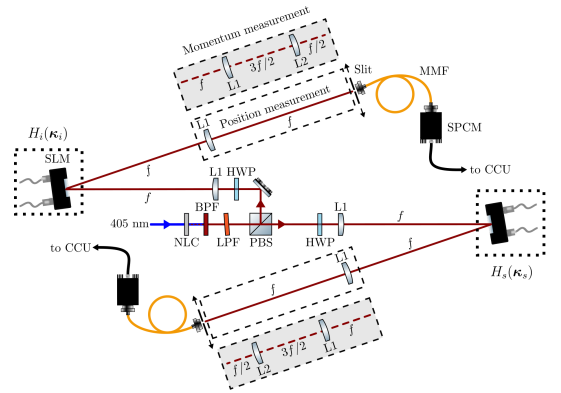Author
Stephen Chapman
Mentor
Robert Boyd
Abstract
Two-Color Nonlocal Aberration Cancellation is one of the many exciting applications of quantum entanglement. In this experiment we create position-momentum entangled photons via SPDC. We act on the signal photon using an deformable mirror to create aberrations. The idler photon runs into an SLM that is programed with the opposite aberration. Since the photons are entangled, the deformable mirror cancels out the aberrations on both the signal and idler photons. This will hopefully have applications in adaptive optics and quantum imaging.

A. N. Black, E. Giese, B. Braverman, N. Zollo, and R. W. Boyd, “Quantum, Nonlocal Aberration Cancellation,”
Progress
The experimental setup has been fully constructed. The first thing we did was obtain a focused image of the crystal on the ICCD camera. This ensured that our optical system was setup correctly. We then calibrated the SLM. This gave us a correlation between the grey value of the SLM’s pixels and the phase it puts on the beam. This will allow us to code aberrations onto the SLM easily later on.
Setting up the APD was a challenge because we kept having issues with optical components in our system. After much troubleshooting, we found that our system had an out of spec. filter, our 532nm laser was leaking 1064nm light, and scattered light was hindering our APD. After sorting all this out, we confirmed that we had down conversion counts on the APD.
The next step was to set up the APD to trigger the camera to detect the idler photon. We estimated the delay in the trigger signal, and built a delay line to the ICCD that would give the trigger signal enough time to reach the camera before the idler photon did. After much trial and error, we obtained coincidence counts. This verifies entanglement, and is an important intermediate result.
The next step is to construct a ghost imaging setup, and then add aberrations.
Acknowledgements
This project is funded by the U.S. Department of Energy. I would also like to thank Dr. Robert Boyd and PhD student Nick Black for their guidance and supervision on this project.
